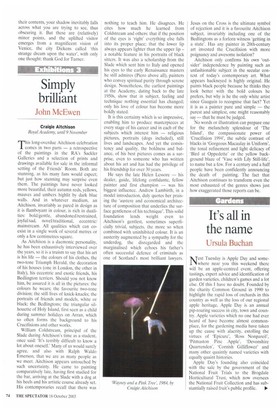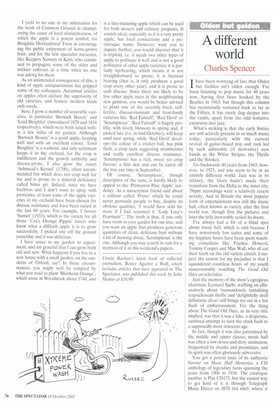It's all in the name
Ursula Buchan
Next Tuesday is Apple Day and somewhere near you this weekend there will be an apple-centred event, offering tastings, expert advice and identification of garden varieties, children's games and a lot else. Of this I have no doubt. Founded by the charity Common Ground in 1990 to highlight the rapid loss of orchards in this country as well as the loss of our regional apple heritage, Apple Day is an annual pip-roaring success in city, town and country. Apple varieties which no one had ever heard of have become almost commonplace, for the gardening media have taken up the cause with alacrity, extolling the virtues of 'Epicure', 'Ross Nonpareil', `Pitmaston Pine Apple', 'Devonshire Quarrenden', 'Cornish Gilliflower' and many other quaintly named varieties with equally quaint histories.
Apple Day's founding also coincided with the sale by the government of the National Fruit Trials to the Brogdale Horticultural Trust, which now oversees the National Fruit Collection and has sub stantially raised fruit's public profile. 110. I yield to no one in my admiration for the work of Common Ground in championing the cause of local distinctiveness, of which the apple is a potent symbol, for Brogdale Horticultural Trust in encouraging the public enjoyment of home-grown fruit, and for the few specialist nurseries, like Keepers Nursery in Kent, who continued to propagate some of the older and trickier cultivars at a time when no one was asking for them.
As an unintended consequence of this, a kind of apple antiquarianism has gripped some of my colleagues. Autumnal articles on apples often declare the superiority of old varieties, and feature modern kinds only rarely.
Sure, I grow a number of venerable varieties, in particular `Barnack Beauty' and 'Lord Burghley' (introduced 1870 and 1834 respectively), which were both raised within a few miles of my garden. Although `Barnack Beauty' is a good apple, keeping well and with an excellent colour, 'Lord Burghley' is a washout, and only sentiment keeps it in the orchard, for the crop is indifferent and the growth unthrifty and disease-prone. I also grow the russet 'Ashmead's Kernel' (1700), often recommended but which does not crop well for me and is prone to a mineral deficiency called bitter pit. Indeed, since we have beehives and I don't want to spray with pesticides, at least some of the apple varieties in my orchard have been chosen for disease resistance and have been raised in the last 80 years. For example, I favour 'Sunset' (1933), which is the variety for all those 'Cox's Orange Pippin' lovers who know what a difficult apple it is to grow successfully. I picked one off the ground yesterday and it was delicious.
I have space in my garden to experiment, and am grateful that I can grow both old and new. What happens if you live in a new house with a small garden, on the outskirts of Oxford, say? In these circumstances, you might well be tempted by what you read to plant 'Blenheim Orange', which arose in Woodstock about 1740, and is a late-maturing apple which can be used for both dessert and culinary purposes. It sounds ideal, especially as it is a very pretty apple, has local connections and a picturesque name. However, were you to inquire further, you would discover that it is triploid, i.e. it needs two other types of apple to pollinate it well and is not a good pollinator of other apple varieties; it is partially tip-bearing, which means it is not straightforward to prune; it is biennial bearing (that is, it only produces a good crop every other year), and it is prone to scab disease. Since there are likely to be few other apple trees in the neighbouring new gardens, you would be better advised to plant one of the recently bred, selffertile, disease-resistant and frost-hardy varieties like 'Red Falstaff, 'Red Devil' or 'Scrumptious'. 'Red Falstaff is hugely prolific, with lovely blossom in spring and, if picked late (i.e. in mid-October), will keep until next spring, while 'Red Devil' develops the colour of a cricket ball, has pink flesh, a crisp taste suggesting strawberries and really excellent disease resistance. 'Scrumptious' has a rich, sweet yet crisp flavour, a thin skin and can be eaten off the tree any time in September.
Of course, 'Scrumptious', though descriptive of the taste, is hardly likely to appeal to the `Pitmaston Pine Apple' tendency. As a nurseryman friend said about a cultivar called 'Prima' which he could never persuade people to buy, despite its obvious qualities, 'I would have sold far more if I had renamed it "Lady Lucy's Pearmain".' The truth is that, if you only have room in your garden for one tree, and you want an apple that produces generous quantities of clean, delicious fruit without a lot of messing about, 'Scrumptious' is the one. Although you may search in vain for a mention of it in this weekend's papers.
Ursula Buchan 's latest book of collected journalism, Better Against a Wall, which includes articles that have appeared in The Spectator, was published this week by John Murray at £16.99.



































































































 Previous page
Previous page